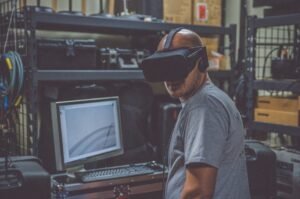Make AI Using Python
Artificial Intelligence (AI) is a rapidly growing field that has the potential to revolutionize various industries. With Python, a powerful and versatile programming language, it is now easier than ever to dive into the world of AI development. This article will provide you with an introduction to making AI using Python and will guide you through the process of getting started.
Key Takeaways:
- AI development is made more accessible with Python’s capabilities.
- Python offers a wide range of libraries and frameworks for implementing AI algorithms.
- Understanding machine learning concepts is essential for AI development in Python.
- Python provides tools for data preprocessing, model training, and evaluation.
If you are new to AI and Python, it’s important to get familiar with the necessary tools and concepts. Python offers several key libraries and frameworks that make AI development easier, such as TensorFlow, Keras, and Scikit-learn. These libraries provide pre-implemented algorithms and functions that can be used to build AI models. Additionally, Jupyter Notebook is a popular interactive development environment for Python that allows you to experiment with AI algorithms and visualize results in real-time.
Machine learning is at the core of AI development, and Python provides robust support for building machine learning models. The *scikit-learn* library offers a wide range of machine learning algorithms, including classification, regression, clustering, and dimensionality reduction. These algorithms can be trained on large datasets to make predictions or extract insights. For example, you can use a decision tree algorithm to classify emails as spam or non-spam based on their content.
One interesting aspect of AI development is deep learning, which is a subfield of machine learning focused on neural networks and complex hierarchical models. Python’s TensorFlow library is a powerful tool for deep learning tasks and has gained significant popularity due to its flexibility and scalability. With TensorFlow, you can build and train deep neural networks capable of performing complex tasks like image recognition or natural language processing.
Python Libraries for AI Development
Python offers a rich ecosystem of libraries and frameworks that can be used for AI development. Here are a few popular choices:
| Library | Description |
|---|---|
| TensorFlow | A comprehensive library for numerical computation and machine learning. |
| Keras | A high-level neural networks API, running on top of TensorFlow. |
| Scikit-learn | A versatile library for machine learning, including classification and regression. |
Python provides extensive support for handling and preprocessing data, which is a critical step in AI development. The pandas library offers powerful data manipulation and analysis capabilities, allowing you to clean and transform datasets. You can explore relationships between data variables using the matplotlib and seaborn libraries for data visualization. Moreover, numpy provides efficient numerical computing functions that are essential for AI algorithms.
When building AI models, it is crucial to evaluate their performance. Python provides tools to assess the accuracy of AI algorithms through metrics such as accuracy, precision, and recall. The scikit-learn library offers functions for computing these metrics, along with techniques for cross-validation and hyperparameter tuning. Using appropriate evaluation techniques helps ensure that AI models perform well on unseen data and generalize to real-world scenarios.
Getting Started with AI Development in Python
Now that you have an overview of the tools and libraries available for AI development in Python, it’s time to get started. Follow these steps to embark on your AI journey:
- Learn the fundamentals of Python programming language, including data types, control flow, and functions.
- Get familiar with machine learning concepts, such as supervised and unsupervised learning, as well as basic algorithms like linear regression and decision trees.
- Choose a specific AI project or problem you want to work on. Define clear objectives and determine the required data.
- Preprocess your data by cleaning, transforming, and normalizing it. Utilize the pandas library for efficient data handling.
- Select a suitable machine learning algorithm or a neural network architecture from libraries like scikit-learn or TensorFlow.
- Train your model using the available data and adjust the model’s parameters to improve performance.
- Evaluate your model’s performance using appropriate metrics and validation techniques.
- Iterate on your AI model by fine-tuning parameters, exploring different algorithms, or incorporating ensemble techniques.
- Deploy your AI model in a real-world setting and continuously monitor its performance.
Remember, mastering AI development using Python is a continuous learning process. Keep exploring and experimenting with new techniques and algorithms to stay updated in this exciting and rapidly evolving field.
Start your journey into AI development with Python today, and unlock the potential of this powerful combination.

Common Misconceptions
Misconception 1: AI is all about robots
One common misconception about AI is that it is all about robots. While robots can incorporate AI technology, AI itself is not limited to robotics. AI refers to the simulation of human intelligence in machines, which can be applied to various fields such as computer vision, natural language processing, and data analysis.
- AI can be applied to software systems without physical presence of robots.
- AI technologies are used in voice assistants like Siri and Alexa, which do not have a physical body.
- Applications of AI also include spam filters, recommendation engines, and facial recognition systems.
Misconception 2: AI will replace humans
Another misconception is that AI will completely replace humans in the workforce, leading to widespread unemployment. While AI has the potential to automate certain tasks and processes, it is not intended to replace human intelligence and creativity.
- AI is designed to enhance human capabilities, not replace them.
- AI can handle repetitive and mundane tasks, allowing humans to focus on more complex and strategic activities.
- The collaboration between humans and AI can lead to increased productivity and efficiency in various industries.
Misconception 3: All AI systems are self-aware
A common misconception is that all AI systems possess self-awareness and consciousness, similar to humans. However, most AI systems are designed to perform specific tasks and operate within predefined limits without consciousness or awareness.
- AI systems are created to execute specific functions based on algorithms and data, without having thoughts or emotions.
- AI is focused on problem-solving and decision-making based on data analysis, rather than possessing self-awareness.
- Emulating human consciousness and self-awareness is an active area of research in the field of AI, but it is not the main purpose of most current AI systems.
Misconception 4: AI is always accurate and infallible
Another misconception is that AI systems are always accurate and infallible. While AI has made significant advancements, it is still prone to errors and limitations.
- AI systems heavily rely on the quality and quantity of the data they are trained on, which can impact their accuracy.
- Biases present in the training data can lead to biased decision-making by AI systems.
- Ongoing monitoring and evaluation of AI systems are necessary to ensure their accuracy and address any issues that may arise.
Misconception 5: AI is only for experts and programmers
Lastly, it is a common misconception that AI is only accessible to experts and programmers. While expertise in programming and data science can certainly be advantageous, there are tools and platforms available that make it easier for non-technical individuals to leverage AI for various purposes.
- Many software applications and online services offer AI functionalities that can be used by non-programmers.
- AI libraries and frameworks, such as TensorFlow and PyTorch, have user-friendly interfaces and documentation for beginners.
- AI courses and tutorials are available online to help individuals without programming experience get started with AI concepts and implementations.

Python Libraries for AI Development
Python is widely used in the field of Artificial Intelligence due to its simplicity, extensive libraries, and powerful frameworks. The following tables showcase some popular Python libraries used in AI development and their respective functionalities.
Machine Learning Libraries
Machine learning libraries provide tools and algorithms for building models that can learn from and make predictions or decisions based on data.
| Library | Description |
|---|---|
| Scikit-learn | A comprehensive library for various machine learning tasks, including classification, regression, clustering, and dimensionality reduction. |
| TensorFlow | An open-source library developed by Google, mainly used for deep learning and neural networks. |
| Keras | A high-level neural networks library built on top of TensorFlow, focusing on simplicity and user-friendliness. |
| PyTorch | An open-source library primarily used for deep learning and provides dynamic computational graphs. |
Natural Language Processing (NLP) Libraries
NLP libraries offer functionalities for analyzing, understanding, and generating human language text.
| Library | Description |
|---|---|
| NLTK | A comprehensive platform with a vast collection of tools and resources for NLP tasks such as tokenization, stemming, and parsing. |
| spaCy | An industrial-strength NLP library that provides efficient tokenization, part-of-speech tagging, and named entity recognition. |
| Gensim | A library for topic modeling, document similarity analysis, and other vector space modeling techniques. |
Computer Vision Libraries
Computer vision libraries enable the processing, analysis, and understanding of visual data, such as images and videos.
| Library | Description |
|---|---|
| OpenCV | A popular library that provides various computer vision algorithms and routines, including image processing, object detection, and feature extraction. |
| Scikit-image | A collection of image processing algorithms, which can be seamlessly integrated with other machine learning libraries. |
Deep Reinforcement Learning Libraries
Deep reinforcement learning libraries enable the development of AI agents that can learn optimal behavior through interaction with an environment.
| Library | Description |
|---|---|
| TensorForce | A library specifically designed for developing and training deep reinforcement learning models. |
| Stable Baselines | A set of high-level reinforcement learning algorithms with various policy architectures and support for parallelization. |
Conclusion
Python provides a vast ecosystem of libraries catering to different aspects of AI development. These libraries empower developers and researchers to build sophisticated AI systems and manipulate complex data with ease. Whether it’s machine learning, natural language processing, computer vision, or deep reinforcement learning, Python offers the necessary tools to propel the field of AI forward.
Make AI Using Python: Frequently Asked Questions
Question: What is AI?
Answer: Artificial Intelligence (AI) refers to the simulation of human intelligence in machines that are programmed to mimic human cognitive abilities, such as learning, problem-solving, and decision-making.
Question: How can I make AI using Python?
Answer: Python is a popular programming language that provides various libraries and frameworks for AI development. To make AI using Python, you can utilize libraries such as TensorFlow, PyTorch, and scikit-learn, which offer tools and resources for machine learning and neural networks.
Question: What skills do I need to make AI using Python?
Answer: To make AI using Python, it is helpful to have a solid understanding of Python programming language, as well as knowledge in statistics, linear algebra, and machine learning concepts. Familiarity with specific libraries and frameworks like TensorFlow or PyTorch would also be beneficial.
Question: Are there any Python AI tutorials available?
Answer: Yes, there are numerous Python AI tutorials available online. Many websites, blogs, and video platforms offer step-by-step guides, code examples, and demonstrations on building AI models using Python. You can also find comprehensive courses on AI and machine learning that specifically focus on Python programming.
Question: Can I create AI without programming knowledge?
Answer: While programming knowledge is highly recommended for creating AI, there are some user-friendly tools and platforms available that allow individuals with minimal programming knowledge to build AI models. However, having a solid understanding of programming concepts and Python will still be advantageous for more complex AI projects.
Question: Are there any open-source AI projects in Python?
Answer: Yes, there are numerous open-source AI projects in Python available on platforms like GitHub. These projects cover a wide range of AI applications, including natural language processing, computer vision, and predictive modeling. You can browse through these projects, contribute to them, or utilize them as a starting point for your own AI projects.
Question: Can Python AI models be deployed in production environments?
Answer: Yes, Python AI models can be deployed in production environments. Python provides various tools, frameworks, and APIs that facilitate the deployment of AI models. Platforms like Flask, Django, and TensorFlow Serving allow you to expose your AI models as web services or integrate them into larger applications.
Question: Is Python the only programming language used for AI?
Answer: No, Python is not the only programming language used for AI. While Python is highly popular for AI development due to its simplicity and extensive library support, other languages like R, Java, and C++ are also used in AI projects. The choice of programming language often depends on the specific requirements and preferences of the AI developers.
Question: How long does it take to make AI using Python?
Answer: The time required to make AI using Python can vary significantly depending on the complexity of the AI project, your prior programming knowledge, and the availability of relevant data. Simple AI models can be created in a relatively short time, while more advanced projects may take weeks or even months to complete.
Question: Where can I find AI datasets for Python?
Answer: There are several sources where you can find AI datasets for Python. Some popular platforms include Kaggle, UCI Machine Learning Repository, and Google’s Dataset Search. These platforms offer a wide range of datasets that can be used for various AI applications, such as image recognition, speech processing, and sentiment analysis.





